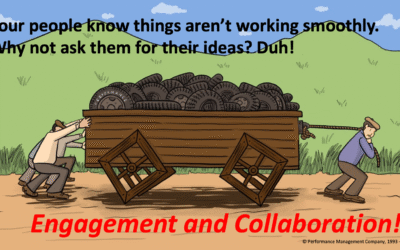I responded to a LinkedIn post about the issues of innovation and implementation. It was started by a well-known management professor who deals with Very Senior Executives and who talked about starting their sessions with sticky notes and 5 minutes for ideas for improvement. The comment was that executives generate 70% of their notes about products and not about people or teamwork or culture or any of those other important things that drive performance.
That makes sense. I think that most executives think more about THINGS than they do about the process of making things better. Doing the latter will often involve change and structural reframing which are often problematic and involve all sorts of effort and involvement. Products? Yeah, that is a lot less complicated…
Let’s see, let’s do a new teambuilding board game focused on trust and zombies…
My thought was that the basic framework of the activity might change a little, to be more group-process focused and to use an inkblot of some kind to generate broader perspective around making organizational progress. It seems to me that a little restructuring of the activity might generate a broader picture of how things really work.
“A desk is a dangerous place from which to view the world.”
That is for sure! The quote was embedded in a John LeCarre novel I read a couple dozen years ago, but it stuck with me. You bring the executives together and you give them yellow stickies and ask what they would change. Products. Product Innovation — but not from customer input, directly as in Design Thinking. Of course, few of these leaders will think about how things are working around issues of people and performance, even though many of them have metrics about engagement embedded into their compensation. Maybe things are different these days (2022) but the employee turnover numbers show that as a “maybe.” Gallup data shows high levels of active disengagement.
A different approach might be to show them a picture of a wagon rolling on square wheels with a cargo of round tires. The wagon pusher looks forward and pulls a rope while the wagon pushers look at boards and hands. That, many agree, is a much more representative model of how things work in most organizations. So, I would show this image with this question:
- Leaders lead. That is all they see themselves doing.
- Pushers push. That is their job.
- Few things seem to work smoothly from a hands-on kind of reality.
- The view at the back is very much different than the view at the front.
- There IS no mud in the image above and the players are on level ground instead of pushing uphill.
So, asking people to project their ideas onto that wagon generates all sorts of ideas about issues and opportunities. Some might focus on the round wheels (products) but they simply cannot ignore the reality of motivating and engaging the wagon pushers if they are to make progress.
Plus, we suggest that the executives (or workers) work as tabletops of 6 so that the truly awful ideas get little support and the good ones generate some ownership involvement.
Plus, it is NOT simply about ideas. We know, based on all sorts of research, that 9 of 10 strategy or change improvement initiatives fail, often because of poor alignment and communications. And don’t push YOUR idea down and expect ME to support it — the reality is that, “Nobody ever washes a rental car” and if you do not share ownership involvement in the creation or at least the implementation strategy, you will simply generate all sorts of resistance.
I know that I do not have The Answer. But I do know that the round wheels almost always exist in the wagon.
Don’t just DO something, Stand There!
Step Back. Stop. Take a look at how things are really working. Are people focused on My Team, and My Team only? Are they up to their axles in mud and surrounded by Spectator Sheep whose constant Naaaaaa Baaaaaaa’s are interfering with team morale and change, and are the teams competitive and even sabotaging the efforts of other teams (a blog on engagement, non-engagement and sabotage is here).
I make some supporting suggestions here in another blog on people and performance: http://performancemanagementcompanyblog.com/2014/08/07/7-things-you-should-do-differently-to-build-better-teamwork/
—
For the FUN of It!
 Dr. Scott Simmerman is a designer of team building games and organization improvement tools.
Dr. Scott Simmerman is a designer of team building games and organization improvement tools.
Managing Partner of Performance Management Company since 1984, he is an experienced presenter and consultant who is trying to retire!! He now lives in Cuenca, Ecuador.
You can reach Scott at scott@squarewheels.com
Learn more about Scott at his LinkedIn site.
Here is a 2-minute overview of the virtual team building game: https://www.youtube.com/watch?v=cE6gDtZymwk
Square Wheels® are a registered trademark of Performance Management Company
.








How companies can nurture innovation and motivate their talents to bring innovations forward?
Each company is destined to get the results it gets. What I mean by this is that poor organization, lack of solid and sustainable innovation culture lead to poor results, and more than before, to a company’s trouble or death.
Smart business leaders shape the culture of their company to drive innovation. Success and constant positive results come from the implementation and execution of strategies, business models, structure, processes, technologies and incentive systems that encourage innovation.
If you would like to read more about learning innovation, you can access to my blog on: http://worldofinnovations.net/2014/08/11/7-ways-to-create-a-culture-of-innovation/